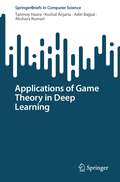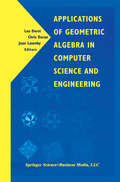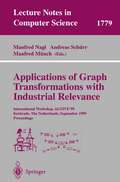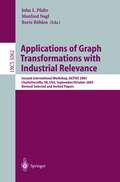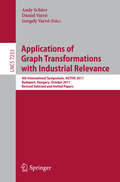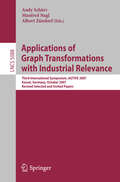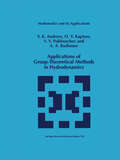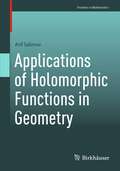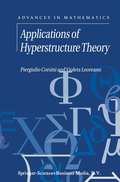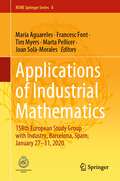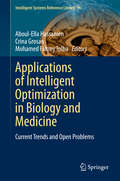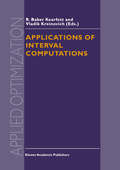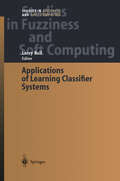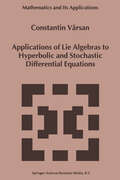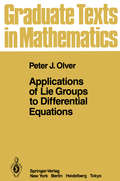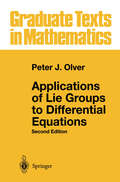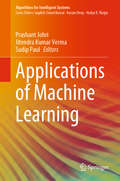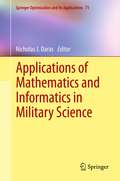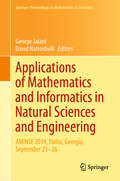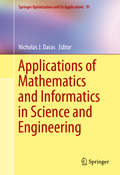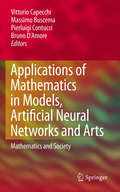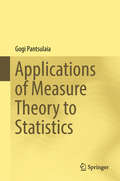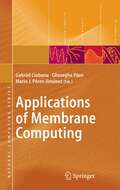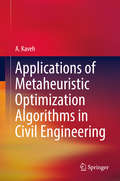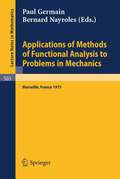- Table View
- List View
Applications of Game Theory in Deep Learning (SpringerBriefs in Computer Science)
by Tanmoy Hazra Kushal Anjaria Aditi Bajpai Akshara KumariThis book aims to unravel the complex tapestry that interweaves strategic decision-making models with the forefront of deep learning techniques. Applications of Game Theory in Deep Learning provides an extensive and insightful exploration of game theory in deep learning, diving deep into both the theoretical foundations and the real-world applications that showcase this intriguing intersection of fields. Starting with the essential foundations for comprehending both game theory and deep learning, delving into the individual significance of each field, the book culminates in a nuanced examination of Game Theory's pivotal role in augmenting and shaping the development of Deep Learning algorithms. By elucidating the theoretical underpinnings and practical applications of this synergistic relationship, we equip the reader with a comprehensive understanding of their combined potential. In our digital age, where algorithms and autonomous agents are becoming more common, the combination of game theory and deep learning has opened a new frontier of exploration. The combination of these two disciplines opens new and exciting avenues. We observe how artificial agents can think strategically, adapt to ever-shifting environments, and make decisions that are consistent with their goals and the dynamics of their surroundings. This book presents case studies, methodologies, and real-world applications.
Applications of Geometric Algebra in Computer Science and Engineering
by Leo Dorst Chris Doran Joan LasenbyGeometric algebra has established itself as a powerful and valuable mathematical tool for solving problems in computer science, engineering, physics, and mathematics. The articles in this volume, written by experts in various fields, reflect an interdisciplinary approach to the subject, and highlight a range of techniques and applications. Relevant ideas are introduced in a self-contained manner and only a knowledge of linear algebra and calculus is assumed. Features and Topics: * The mathematical foundations of geometric algebra are explored * Applications in computational geometry include models of reflection and ray-tracing and a new and concise characterization of the crystallographic groups * Applications in engineering include robotics, image geometry, control-pose estimation, inverse kinematics and dynamics, control and visual navigation * Applications in physics include rigid-body dynamics, elasticity, and electromagnetism * Chapters dedicated to quantum information theory dealing with multi- particle entanglement, MRI, and relativistic generalizations Practitioners, professionals, and researchers working in computer science, engineering, physics, and mathematics will find a wide range of useful applications in this state-of-the-art survey and reference book. Additionally, advanced graduate students interested in geometric algebra will find the most current applications and methods discussed.
Applications of Graph Transformations with Industrial Relevance: International Workshop, AGTIVE'99 Kerkrade, The Netherlands, September 1-3, 1999 Proceedings (Lecture Notes in Computer Science #1779)
by Manfred Nagl Andreas Schürr Manfred MünchThis book constitutes the thoroughly refereed post-proceedings of the International Workshop on Graph Transformation with Industrial Relevance, AGTIVE'99, held in Kerkrade, The Netherlands, in June 1999.The 28 revised full papers presented went through an iterated process of reviewing and revision. Also included are three invited papers, 10 tool demonstrations, a summary of a panel discussion, and lists of graph transformation systems and books on graph transformations. The papers are organized in sections on modularization concepts, distributed systems modeling, software architecture: evolution and reengineering, visual graph transformation languages, visual language modeling and tool development, knowledge modeling, image recognition and constraint solving, process modeling and view integration, and visualization and animation tools.
Applications of Graph Transformations with Industrial Relevance: Second International Workshop, AGTIVE 2003, Charlottesville, VA, USA, September 27 - October 1, 2003, Revised Selected and Invited Papers (Lecture Notes in Computer Science #3062)
by John L. Pfaltz Manfred Nagl Boris BöhlenApplications of Graph Transformations with Industrial Relevance: 4th International Symposium, AGTIVE 2011, Budapest, Hungary, October 4-7, 2011, Revised Selected Papers (Lecture Notes in Computer Science #7233)
by Gergely Varró Andy Schürr Dániel VarróThis book constitutes the thoroughly refereed post-conference proceedings of the 4th International Symposium on Applications of Graph Transformations, AGTIVE 2011, held in Budapest, Hungary, in October 2011. The 13 revised full papers presented together with 2 invited talks, 2 application reports and 3 tool demonstration papers were carefully selected from 36 submissions during two rounds of reviewing and improvement. The papers are organized in topical sections on invited talk abstracts, model-driven engineering, graph transformation applications, tool demonstrations, graph transformation exploration techniques, graph transformation semantics and reasoning, application reports and bidirectional transformations.
Applications of Graph Transformations with Industrial Relevance: Third International Symposium, AGTIVE 2007, Kassel, Germany, October 10-12, 2007, Revised Selected and Invited Papers (Lecture Notes in Computer Science #5088)
by Albert Zündorf Andy Schürr Manfred NaglThis book constitutes the thoroughly refereed post-conference proceedings of the Third International Symposium on Applications of Graph Transformations, AGTIVE 2007, held in Kassel, Germany, in October 2007. The 30 revised full papers presented together with 2 invited papers were carefully selected from numerous submissions during two rounds of reviewing and improvement. The papers are organized in topical sections on graph transformation applications, meta-modeling and domain-specific language, new graph transformation approaches, program transformation applications, dynamic system modeling, model driven software development applications, queries, views, and model transformations, as well as new pattern matching and rewriting concepts. The volume moreover contains 4 papers resulting from the adjacent graph transformation tool contest and concludes with 9 papers summarizing the state of the art of today's available graph transformation environments.
Applications of Group-Theoretical Methods in Hydrodynamics (Mathematics and Its Applications #450)
by V.K. Andreev O.V. Kaptsov Vladislav V. Pukhnachev A.A. RodionovIt was long ago that group analysis of differential equations became a powerful tool for studying nonlinear equations and boundary value problems. This analysis was especially fruitful in application to the basic equations of mechanics and physics because the invariance principles are already involved in their derivation. It is in no way a coincidence that the equations of hydrodynamics served as the first object for applying the new ideas and methods of group analysis which were developed by 1. V. Ovsyannikov and his school. The authors rank themselves as disciples of the school. The present monograph deals mainly with group-theoretic classification of the equations of hydrodynamics in the presence of planar and rotational symmetry and also with construction of exact solutions and their physical interpretation. It is worth noting that the concept of exact solution to a differential equation is not defined rigorously; different authors understand it in different ways. The concept of exact solution expands along with the progress of mathematics (solu tions in elementary functions, in quadratures, and in special functions; solutions in the form of convergent series with effectively computable terms; solutions whose searching reduces to integrating ordinary differential equations; etc. ). We consider it justifiable to enrich the set of exact solutions with rank one and rank two in variant and partially invariant solutions to the equations of hydrodynamics.
Applications of Holomorphic Functions in Geometry (Frontiers in Mathematics)
by Arif SalimovThis book expounds on the recent developments in applications of holomorphic functions in the theory of hypercomplex and anti-Hermitian manifolds as well as in the geometry of bundles. It provides detailed information about holomorphic functions in algebras and discusses some of the areas in geometry with applications. The book proves the existence of a one-to-one correspondence between hyper-complex anti-Kähler manifolds and anti-Hermitian manifolds with holomorphic metrics, and also a deformed lifting to bundles. Researchers and students of geometry, algebra, topology and physics may find the book useful as a self-study guide.
Applications of Industrial Mathematics: 158th European Study Group with Industry, Barcelona, Spain, January 27–31, 2020 (RSME Springer Series #8)
by Maria Aguareles Francesc Font Tim Myers Marta Pellicer Joan Solà-MoralesThis book collects the results presented at the 158th European Study Group with Industry, which took place at the Centre de Recerca Matemàtica in Barcelona in January 2020. The European Study Groups with Industry are a well-recognised forum where mathematicians work with industrial representatives on issues of current interest to companies. At this particular meeting, the problems were chosen to provide a wide variety of subject areas and to appeal to local academics. In this work, the research carried out and the solutions presented to the companies are detailed. In particular, the book focuses on: estimating the difficulty level of mobile games; modelling the stability of human towers; fibre coating in the manufacture of clutch components; safe trajectories of robot arms. The book provides an excellent addition to the canon of Industrial Mathematics. It is addressed to researchers keen to apply mathematics to topical, real-world problems.
Applications of Intelligent Optimization in Biology and Medicine: Current Trends and Open Problems (Intelligent Systems Reference Library #96)
by Aboul-Ella Hassanien Crina Grosan Mohamed Fahmy TolbaThis volume provides updated, in-depth material on the application of intelligent optimization in biology and medicine. The aim of the book is to present solutions to the challenges and problems facing biology and medicine applications. This Volume comprises of 13 chapters, including an overview chapter, providing an up-to-date and state-of-the research on the application of intelligent optimization for bioinformatics applications, DNA based Steganography, a modified Particle Swarm Optimization Algorithm for Solving Capacitated Maximal Covering Location Problem in Healthcare Systems, Optimization Methods for Medical Image Super Resolution Reconstruction and breast cancer classification. Moreover, some chapters that describe several bio-inspired approaches in MEDLINE Text Mining, DNA-Binding Proteins and Classes, Optimized Tumor Breast Cancer Classification using Combining Random Subspace and Static Classifiers Selection Paradigms, and Dental Image Registration. The book will be a useful compendium for a broad range of readers—from students of undergraduate to postgraduate levels and also for researchers, professionals, etc.—who wish to enrich their knowledge on Intelligent Optimization in Biology and Medicine and applications with one single book.
Applications of Interval Computations (Applied Optimization #3)
by R. Baker Kearfott V. KreinovichPrimary Audience for the Book • Specialists in numerical computations who are interested in algorithms with automatic result verification. • Engineers, scientists, and practitioners who desire results with automatic verification and who would therefore benefit from the experience of suc cessful applications. • Students in applied mathematics and computer science who want to learn these methods. Goal Of the Book This book contains surveys of applications of interval computations, i. e. , appli cations of numerical methods with automatic result verification, that were pre sented at an international workshop on the subject in EI Paso, Texas, February 23-25, 1995. The purpose of this book is to disseminate detailed and surveyed information about existing and potential applications of this new growing field. Brief Description of the Papers At the most fundamental level, interval arithmetic operations work with sets: The result of a single arithmetic operation is the set of all possible results as the operands range over the domain. For example, [0. 9,1. 1] + [2. 9,3. 1] = [3. 8,4. 2], where [3. 8,4. 2] = {x + ylx E [0. 9,1. 1] and y E [3. 8,4. 2]}. The power of interval arithmetic comes from the fact that (i) the elementary operations and standard functions can be computed for intervals with formulas and subroutines; and (ii) directed roundings can be used, so that the images of these operations (e. g.
Applications of Learning Classifier Systems (Studies in Fuzziness and Soft Computing #150)
by Larry BullThe field called Learning Classifier Systems is populated with romantics. Why shouldn't it be possible for computer programs to adapt, learn, and develop while interacting with their environments? In particular, why not systems that, like organic populations, contain competing, perhaps cooperating, entities evolving together? John Holland was one of the earliest scientists with this vision, at a time when so-called artificial intelligence was in its infancy and mainly concerned with preprogrammed systems that didn't learn. that, like organisms, had sensors, took Instead, Holland envisaged systems actions, and had rich self-generated internal structure and processing. In so doing he foresaw and his work prefigured such present day domains as reinforcement learning and embedded agents that are now displacing the older "standard Af' . One focus was what Holland called "classifier systems": sets of competing rule like "classifiers", each a hypothesis as to how best to react to some aspect of the environment--or to another rule. The system embracing such a rule "popu lation" would explore its available actions and responses, rewarding and rating the active rules accordingly. Then "good" classifiers would be selected and re produced, mutated and even crossed, a la Darwin and genetics, steadily and reliably increasing the system's ability to cope.
Applications of Lie Algebras to Hyperbolic and Stochastic Differential Equations (Mathematics and Its Applications #466)
by Constantin VârsanThe main part of the book is based on a one semester graduate course for students in mathematics. I have attempted to develop the theory of hyperbolic systems of differen tial equations in a systematic way, making as much use as possible ofgradient systems and their algebraic representation. However, despite the strong sim ilarities between the development of ideas here and that found in a Lie alge bras course this is not a book on Lie algebras. The order of presentation has been determined mainly by taking into account that algebraic representation and homomorphism correspondence with a full rank Lie algebra are the basic tools which require a detailed presentation. I am aware that the inclusion of the material on algebraic and homomorphism correspondence with a full rank Lie algebra is not standard in courses on the application of Lie algebras to hyperbolic equations. I think it should be. Moreover, the Lie algebraic structure plays an important role in integral representation for solutions of nonlinear control systems and stochastic differential equations yelding results that look quite different in their original setting. Finite-dimensional nonlin ear filters for stochastic differential equations and, say, decomposability of a nonlinear control system receive a common understanding in this framework.
Applications of Lie Groups to Differential Equations (Graduate Texts in Mathematics #107)
by Peter J. OlverThis book is devoted to explaining a wide range of applications of con tinuous symmetry groups to physically important systems of differential equations. Emphasis is placed on significant applications of group-theoretic methods, organized so that the applied reader can readily learn the basic computational techniques required for genuine physical problems. The first chapter collects together (but does not prove) those aspects of Lie group theory which are of importance to differential equations. Applications covered in the body of the book include calculation of symmetry groups of differential equations, integration of ordinary differential equations, including special techniques for Euler-Lagrange equations or Hamiltonian systems, differential invariants and construction of equations with pre scribed symmetry groups, group-invariant solutions of partial differential equations, dimensional analysis, and the connections between conservation laws and symmetry groups. Generalizations of the basic symmetry group concept, and applications to conservation laws, integrability conditions, completely integrable systems and soliton equations, and bi-Hamiltonian systems are covered in detail. The exposition is reasonably self-contained, and supplemented by numerous examples of direct physical importance, chosen from classical mechanics, fluid mechanics, elasticity and other applied areas.
Applications of Lie Groups to Differential Equations (Graduate Texts in Mathematics #107)
by Peter J. OlverA solid introduction to applications of Lie groups to differential equations which have proved to be useful in practice. The computational methods are presented such that graduates and researchers can readily learn to use them. Following an exposition of the applications, the book develops the underlying theory, with many of the topics presented in a novel way, emphasising explicit examples and computations. Further examples, as well as new theoretical developments, appear in the exercises at the end of each chapter.
Applications of Machine Learning (Algorithms for Intelligent Systems)
by Prashant Johri Jitendra Kumar Verma Sudip PaulThis book covers applications of machine learning in artificial intelligence. The specific topics covered include human language, heterogeneous and streaming data, unmanned systems, neural information processing, marketing and the social sciences, bioinformatics and robotics, etc. It also provides a broad range of techniques that can be successfully applied and adopted in different areas. Accordingly, the book offers an interesting and insightful read for scholars in the areas of computer vision, speech recognition, healthcare, business, marketing, and bioinformatics.
Applications of Mathematics and Informatics in Military Science (Springer Optimization and Its Applications #71)
by Nicholas J. DarasAnalysis, assessment, and data management are core tools required for operation research analysts. The April 2011 conference held at the Helenic Military Academy addressed these issues with efforts to collect valuable recommendations for improving analysts’ capabilities to assess and communicate the necessary qualitative data to military leaders. This unique volume is an outgrowth of the April conference and comprises of contributions from the fields of science, mathematics, and the military, bringing Greek research findings to the world. Topics cover a wide variety of mathematical methods used with application to defense and security. Each contribution considers directions and pursuits of scientists that pertain to the military as well as the theoretical background required for methods, algorithms, and techniques used in military applications. The direction of theoretical results in these applications is conveyed and open problems and future areas of focus are highlighted. A foreword will be composed by a member of N.A.T.O. or a ranking member of the armed forces. Topics covered include: applied OR and military applications, signal processing, scattering, scientific computing and applications, combat simulation and statistical modeling, satellite remote sensing, and applied informatics – cryptography and coding. The contents of this volume will be of interest to a diverse audience including military operations research analysts, the military community at large, and practitioners working with mathematical methods and applications to informatics and military science.
Applications of Mathematics and Informatics in Natural Sciences and Engineering: AMINSE 2019, Tbilisi, Georgia, September 23-26 (Springer Proceedings in Mathematics & Statistics #334)
by George Jaiani David NatroshviliThis book presents peer-reviewed papers from the 4th International Conference on Applications of Mathematics and Informatics in Natural Sciences and Engineering (AMINSE2019), held in Tbilisi, Georgia, in September 2019. Written by leading researchers from Austria, France, Germany, Georgia, Hungary, Romania, South Korea and the UK, the book discusses important aspects of mathematics, and informatics, and their applications in natural sciences and engineering. It particularly focuses on Lie algebras and applications, strategic graph rewriting, interactive modeling frameworks, rule-based frameworks, elastic composites, piezoelectrics, electromagnetic force models, limiting distribution, degenerate Ito-SDEs, induced operators, subgaussian random elements, transmission problems, pseudo-differential equations, and degenerate partial differential equations. Featuring theoretical, practical and numerical contributions, the book will appeal to scientists from various disciplines interested in applications of mathematics and informatics in natural sciences and engineering.
Applications of Mathematics and Informatics in Science and Engineering (Springer Optimization and Its Applications #91)
by Nicholas J. DarasAnalysis, assessment, and data management are core competencies for operation research analysts. This volume addresses a number of issues and developed methods for improving those skills. It is an outgrowth of a conference held in April 2013 at the Hellenic Military Academy and brings together a broad variety of mathematical methods and theories with several applications. It discusses directions and pursuits of scientists that pertain to engineering sciences. It is also presents the theoretical background required for algorithms and techniques applied to a large variety of concrete problems. A number of open questions as well as new future areas are also highlighted.This book will appeal to operations research analysts, engineers, community decision makers, academics, the military community, practitioners sharing the current “state-of-the-art,” and analysts from coalition partners. Topics covered include Operations Research, Games and Control Theory, Computational Number Theory and Information Security, Scientific Computing and Applications, Statistical Modeling and Applications, Systems of Monitoring and Spatial Analysis.
Applications of Mathematics in Models, Artificial Neural Networks and Arts: Mathematics and Society
by Vittorio Capecchi Massimo Buscema Pierluigi Contucci Bruno D'AmoreThe book shows a very original organization addressing in a non traditional way, but with a systematic approach, to who has an interest in using mathematics in the social sciences. The book is divided in four parts: (a) a historical part, written by Vittorio Capecchi which helps us understand the changes in the relationship between mathematics and sociology by analyzing the mathematical models of Paul F. Lazarsfeld, the model of simulation and artificial societies, models of artificial neural network and considering all the changes in scientific paradigms considered; (b) a part coordinated by Pier Luigi Contucci on mathematical models that consider the relationship between the mathematical models that come from physics and linguistics to arrive at the study of society and those which are born within sociology and economics; (c) a part coordinated by Massimo Buscema analyzing models of artificial neural networks; (d) a part coordinated by Bruno D’Amore which considers the relationship between mathematics and art. The title of the book "Mathematics and Society" was chosen because the mathematical applications exposed in the book allow you to address two major issues: (a) the general theme of technological innovation and quality of life (among the essays are on display mathematical applications to the problems of combating pollution and crime, applications to mathematical problems of immigration, mathematical applications to the problems of medical diagnosis, etc.) (b) the general theme of technical innovation and creativity, for example the art and mathematics section which connects to the theme of creative cities. The book is very original because it is not addressed only to those who are passionate about mathematical applications in social science but also to those who, in different societies, are: (a) involved in technological innovation to improve the quality of life; (b) involved in the wider distribution of technological innovation in different areas of creativity (as in the project "Creative Cities Network" of UNESCO).
Applications of Measure Theory to Statistics
by Gogi PantsulaiaThis book aims to put strong reasonable mathematical senses in notions of objectivity and subjectivity for consistent estimations in a Polish group by using the concept of Haar null sets in the corresponding group. This new approach – naturally dividing the class of all consistent estimates of an unknown parameter in a Polish group into disjoint classes of subjective and objective estimates – helps the reader to clarify some conjectures arising in the criticism of null hypothesis significance testing. The book also acquaints readers with the theory of infinite-dimensional Monte Carlo integration recently developed for estimation of the value of infinite-dimensional Riemann integrals over infinite-dimensional rectangles. The book is addressed both to graduate students and to researchers active in the fields of analysis, measure theory, and mathematical statistics.
Applications of Membrane Computing (Natural Computing Series)
by Gabriel Ciobanu Mario J. Pérez-Jiménez Gheorghe P 259 UnMembrane computing is a branch of natural computing which investigates computing models abstracted from the structure and functioning of living cells and from their interactions in tissues or higher-order biological structures. The models considered, called membrane systems (P systems), are parallel, distributed computing models, processing multisets of symbols in cell-like compartmental architectures. In many applications membrane systems have considerable advantages – among these are their inherently discrete nature, parallelism, transparency, scalability and nondeterminism. In dedicated chapters, leading experts explain most of the applications of membrane computing reported so far, in biology, computer science, computer graphics and linguistics. The book also contains detailed reviews of the software tools used to simulate P systems.
Applications of Metaheuristic Optimization Algorithms in Civil Engineering
by A. KavehThe book presents recently developed efficient metaheuristic optimization algorithms and their applications for solving various optimization problems in civil engineering. The concepts can also be used for optimizing problems in mechanical and electrical engineering.
